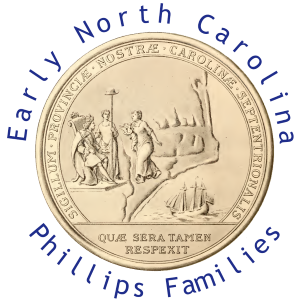Francisco de Chicora
From ENC Phillips Group Wiki
Francisco de Chicora was the name given to a Native American kidnapped in 1521, along with 70 others, from their home, near the mouth of the Pee Dee River by Spanish slave trader Pedro de Quexos and explorer Francisco Gordilla, who were the first Europeans to reach the area.
Gordilla, after leaving his base in Santo Domingo with orders from Lucas Vázquez de Ayllón to explore the continent, ran into his cousin, de Quexos unexpectedly in the Bahamas, trying to catch Arawak slaves there without luck. De Quexos decided to join Gordilla's expedition, and in June the two struck land at the "River of St. John the Baptist" (probably the Pee Dee in what is now South Carolina), where a crowd of curious and amazed natives massed on the shore. These natives fled when the Spanish approached in shallops, but two of them were caught, taken aboard a ship, given Spanish clothes, and returned ashore. According to Peter Martyr's account, the natives again swarmed the beach, seeing this as a wondrous sign, since they had worn only skins; in gratitude, the chief ordered fifty of his subjects to bring food for the Spanish. The Spanish came ashore once more, were given presents and a guided tour for several days, claimed the land for their king, then invited the curious natives aboard to see their ships.
Gordilla had been ordered by de Ayllón to cultivate friendly relations, but De Quexos, eager for slaves, persuaded him to join in betraying the natives' trust; they suddenly raised anchor and set sail for Hispaniola with some 70 of them still aboard, including Francisco. When they arrived home Ayllon condemned them for their treachery and the matter was brought before a commission headed by Diego Columbus; all the natives were declared free. It was also decided to return them, but this never happened as it was considered too dangerous. Peter Martyr reported that most of them died within two years after wandering the streets as vagrants, and the few who remained became servants. He describes them as white, larger than the average Spaniard, and dressed in skins. Francisco de Chicora was one of those who survived, learned Spanish, and gave Peter Martyr much ethnological information about his homeland, Chicora.
In 1526 Ayllon went to North America personally with three ships and 600 colonists, along with de Chicora. When he struck land at what he named the Jordan River (now the Santee River), he lost one of his ships; coming ashore, de Chicora immediately abandoned him, and nothing more is heard of de Chicora.
Native provinces as described to Peter Martyr by Francisco de Chicora and other sources
- Francisco's home province, considered by Swanton to be on the lower Pee Dee River, was called Chicora. These are usually considered a Catawban group; Swanton (1940) proposed a connection with the Sugaree or Shakori; Dr. Rudes suggested Coree.
- Duahre (or Duhare, many variant spellings) was a neighboring province which was home to the king of several provinces, Datha. Ayllon is also said to have marched through this province in 1526, en route to Gualdape, where he built the short-lived colony of San Miguel de Gualdape. The people of Duahre were described as white with very long brown hair, to their feet. Datha and his wife were by far the largest of all. Their precise location and ethnicity has been debated; candidates have included Catawban, Guale, and Cusabo; more recently Rudes asserted that other internal linguistic evidence in Martyr's account points to the Iroquoian Tuscarora tribe, and specifically their town on the Neuse properly called Teyurhèhtè. He cites Old Tuscaroran Teeth-ha, "king", corresponding with the name "Datha", which he says may be a title, as one of his examples.
- Xapita - a province near Duahre where pearls are found, identified with the name of the Sampit River.
- Hitha (Yta) - a province ruled by Datha, possibly Etiwaw (Eutaw), a Cusabo subtribe.
- Tihe - a province of Datha's realm inhabited by a priestly tribe.
- Xamunambe - another of Datha's provinces
- Arambe, Guacaya, Quohathe, Tanzaca (Tanaca), Pahoc - other regions of that country visited by Spanish, having dark brown inhabitants. Swanton suggests that Guacaya may correlate to Waccamaw (a Siouan tribe), and Pahoc to "Back Hooks". Rude connects Quohathe with Coweta (a Muscogee (Creek) subtribe); Tanzaca with "Transequa", a village shown on a 1733 map on the Upper Catawba River; and Arambe with the Ilapi of Hernando de Soto (1541), Herape of Juan Pardo (1568), and the later Creek town Hilibi, which had moved farther west.
- Inziguanin - another country, whose inhabitants were said to have a myth that there had once been crocodile-like men in their land. Rudes suggested Inziguanin could be a reference to the Shawnee, though they were not attested in the area until long afterward.
Other sources, such as Oviedo, Navarrete, Barcia, and Documentos Ineditos list additional provinces derived from Francisco de Chicora, some of which have also been tentatively identified by Swanton and others:
- Yamiscaron - the Yamacraw or Yamasee tribe (Guale)
- Orixa - a Cusabo subtribe on Edisto River
- Coçayo - the Coosa of the Cusabo, who lived on the upper South Carolina rivers; another group of Coosa were later mentioned by De Soto in Georgia
- Pasqui - the Pasque of Pardo, inland near the Siouan Waxhaw Tribe
- Aymi - possibly the Hymahi of De Soto and Pardo, placed by Hudson (1990) on the Congaree River, near where it joins the Santee.
- Sona - possibly a Cusabo subtribe on Stono River
- Yenyohol - the Winyaw of Winyah Bay
- Anica, Xoxi, Huaque, Anoxa - uncertain
References
- John R. Swanton, 1922, Bureau of American Ethnology Bulletin 73, Early History of the Creek Indians and their Neighbors p. 32-48
- Dr. Blair Rudes: First Descriptions of an Iroquoian People: Spaniards among the Tuscarora before 1522
